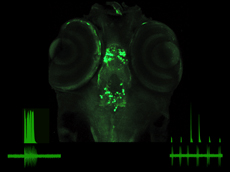Josh Bonkowsky

Associate Professor of Pediatrics
Adjunct Associate Professor of Neurobiology
Director, Pediatric Neurology Research
Developmental Neurobiology
Neurobiology of Disease
Molecular Neuroscience
Education
B.A. 1991, Harvard College; M.D., Ph.D. 2000, University of California, San Diego, 2003-2006, Postdoctoral Fellowship, University of Utah

Transgenic zebrafish; with labeling in the dopamine neurons.
Normal motor development requires input from these neurons.
RESEARCH:
Development of connectivity, axons and synapses. Role and effects of hypoxia on CNS development. Leukodystrophies.
Our research is centered on studying the development of CNS connectivity and neurodevelopmental disorders. Neurodevelopmental disorders are very common, but poorly understood in terms of their pathophysiology and effects on CNS development. To address these disorders, we are taking both a gene-specific approach, as well as a non-biased strategy. We are currently focused on three main areas:
1. Developmental functions of human disease genes.
We are studying the role of several human disease genes on CNS development. For example,
the gene FOXP2 controls the development of language in humans, and we are studying
its role in regulation of axon fasciculation and axon pathfinding. We are also studying
genes involved in human leukodystrophies, and developing a zebrafish model for developing
novel therapies.
2. Development of the basal ganglia.
The basal ganglia play a critical role in the CNS, and dysfunction underlie many common
neurological disorders (cerebral palsy, Parkinson's, and Huntington's, for example).
We have developed unique transgenic lines which specifically label subsets of basal
ganglia neurons, allowing us to perform live visualization of their development. These
transgenic lines are allowing us to analyze which genes are necessary for the development
of basal ganglia connectivity, and the role of genes such as GBA in the development
of Parkinson's disease. Finally, we are determining what genes control reorganization
of neural circuits following CNS injury.
3. Novel techniques for analysis of CNS connectivity.
Understanding how the CNS is wired is extremely complex. We are developing novel technologies
to analyze how genetically distinct neurons recognize and target specific connections,
and what the functional relevance of these connections are. The first technique, the
use of Gal80 in vertebrates, is in press (Fujimoto et al., 2011). The second technique
uses an innovative method to permit trans-synaptic labeling in live animals.
